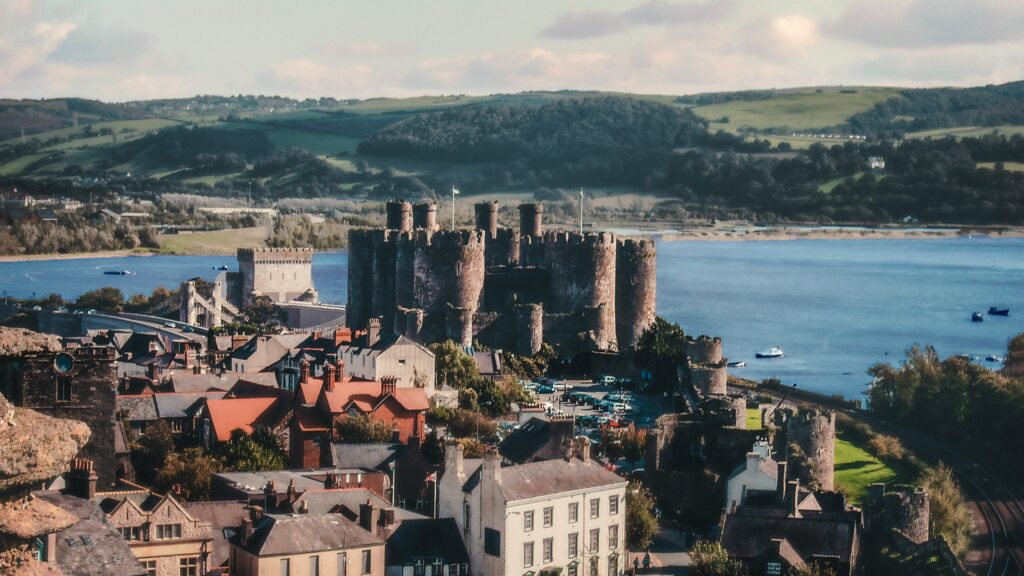Peter Finch reports from a place where there is enough water to drown us all
You can’t see it but it is. The land here is sinking. It has been since the last ice age when the great sheets miles thick that pressed the northern parts of these islands into the ground began to melt. Freed of their encumbrance the rocks below began to lift.
It’s known as post-glacial rebound. Scotland is pushing up into the air at the rate of a centimetre a year. But at our island’s other extremity, down here where the Cornish peninsular and the fringes of Wales face the withering Atlantic, the land is subsiding. It’s descending slowly among its shales, mudstones and limestone sheets. Going down.
I’ve walked it, nearly all of it, along this enormous estuary, at some time or other. It was just land meeting sea when I first encountered it as a child, taken to the pebbles of Penarth to watch the brown waves crash on the grey rocks under a sun reluctant to shine for too long. Did the ground move? Who could imagine such a thing.
Recent decades, however, have seen the results of slow irrevocable change. Fiercer seas, higher coastal walls, flood water on the streets, sandbags where there were never sandbags before. The globe warms and the ice caps return their waters to the oceans. The land sinks as the seas rise.

Coming up the Estuary, a waterway so wide that all sense of land containment has vanished, there is no hint that this ceaseless rippling expanse of grey brown sea might be a harbinger of our collective future. In The Drowned World (Gollanz, 1962) J. G. Ballard postulates a water-locked, dystopian land, barracked with silt and entangled with Jurassic plant life. His drowned future London is a “nightmare world of competing organic forms returning rapidly to their Palaeozoic past”. The planet, but not quite as it is now.
In The Flood (Gollancz, 2008) Stephen Baxter has a different take. Here the waters rise, predictably at first, and then unaccountably fail to stop. They drown the towns, the cities and then move on to the hills. The Welsh mountains and the moors of the West Country become islands. Tors and peaks emerge from the advancing seas as last bastions for civilized life. Eventually all that is left are the high peaks of Snowdon and the crowning rock outcrop of Scafell Pike, phone masts on top. They bear the flags of their nations, a last hurrah to who we were. Then they vanish under the unrelenting waves.
Already the Severn has shown what it can do. Four hundred years ago flood waters swamped the levels on both sides, from Carmarthen to Gloucester. Farms, castles and turnpikes went under. There was great loss of life and, among a God fearing Christian population, the idea that this was retribution, the work of the Devil. The land was filled with dread. From out there on the choppy oceans it could come again. The defences we’ve since built along the coastal edges are testament to our continuing fears. Build a wall. Keep the sea out.
And we could build and build those walls, a great water-repelling stone and iron fence surrounding our countries. The sea risen a hundred meters, the land surface languishing in the dark swampy shadow a hundred metres below. We could save ourselves and, like Malé, capital of the Indian Ocean Maldives built large, hang on as we were. We could do that. But we probably won’t.

Architects, being the visionaries they sometimes are, have proposed alternative futures. Already in Holland houses float. They sit on watertight basements and when the waters flood they rise on their tethers to bob on the water’s surface. When the waters recede they return to hard land. Each dwelling has a floating front path and a small boat. There are also proposals out there for whole retreating cities. Conurbations will be built hard on the coast’s edge but sitting on rails. As the waters advance these new retreating villages with their buildings mounted on concrete skids and iron rails will be dragged back up the coastal plateau to higher ground. Whole urban complexes will shift inland. Architects from the London-based firm Smout Allen have made proposals which suggest that threatened future cities will move as if they were boats being hauled from the waves.
And if our Welsh estuarial conurbations and structures cannot be hauled away from the sea on rails then they could be made to hover. Structures can be attached to air balloons and allowed to move upwards into the skies. Cloud City has already been proposed as an emergency solution for New York should Manhattan succumb to rising water and hurricane. Somehow, though, in the Severn Estuary’s prevailing westerlies I can’t see that quite working here.
Beyond architecture the fantasists have proposed wild fixes that include the use of anti-grav, of magnetic repulsion, of buildings which repel water by chemical solution, of structures which encase themselves in air-tight domes and remain where and as they are – cities created below Eden project roofs, safe in their bubbles below the waves.
What might be the Estuary’s nearer future? As of 2011, following the collapse of part of Fontygary Caravan Park onto the beach below, the Welsh Government has put in place a new flood and coastal erosion strategy . It calls it that and it’s good politics to be seen to be responding to events. In reality, however, it differs little from that which held sway on both the Welsh and English sides of the Channel before. Hold the line and where that’s not possible step back.
There’s a future out there of risen water and steady withdrawal. As the walls are threatened and topped by the sea, first on exceptional days and then increasingly far more regularly, they are left as they are. Managed retreat.
The Severn Estuary, the Severn Sea, the waters where Wales runs out and where England begins. They are such an attraction to those who live nowhere near them. Water has such an enormous pull which is something I, who live right by it, find hard to understand. Back in the days of the USSR’s communist bid for world domination my state-allocated female minder took me on a trip south to the Caspian Sea. I was on an exchange visit, a young writer the communists clearly wanted to influence.
We’d started from land-locked Moscow, where she lived in a regulation tower block among the vodka drinking masses and mamushkas with fat bellies and empty baskets hanging on their arms. My minder was used to life in the cold land-locked northern cities. It was all she knew. We flew south across the great and endless lands of the Soviet Union. When we eventually reached the Caspian, a flat and oil-scummed pool on the sand coloured Steppes, with no rock edge nor wave action, no seaweed, no wind-blown white horses, no seaside paraphernalia of donkey rides and whelk stalls, none of that, she rushed forward and on her knees washed her face in the bitter waters. The sea, the sea. She’d never seen it before. The coast was a place to which she had never been. Despite the oil derricks stretching out across the waters and the presence of the ugly smoking city of Baku to our backs, for her this was a revelatory and holy moment. For me it was just a visit to a distant pond.
On the Severn’s coasts I get the sense that, despite its omnipresence and categorically certain rise, our sense of the sea is in retreat. In the city ports of Bristol, Cardiff, Newport, Barry, Port Talbot and Swansea the docklands are being engulfed by gentrification. Apartments for the rich. Places to dine on lobster and duck with black bean sauce.

Dock traffic is a fraction of what it once was. There are so few ships at sea. The dock labour force has shrivelled. Men do not leave port in trawlers looking for fish. The docklands themselves are surrounded by high security fences, the short cuts down port roads are no longer open, the truncated Royal Navy visit less frequently. They don’t have the ships. The whole sense of us as a maritime nation is in retreat.
City dwellers and, increasingly, too, those who live further out in the dormitory coastal towns and villages, are losing their sense of being by water. They take no part, they do not look. Seafaring words like offing and anchor no longer litter their language. They do not toe the line. They have never slung their hooks. There are those in Gloucestershire who do not know their county has a coast line. I’ve met students in the centre of Cardiff who do not regard the capital as a port city, are unaware of the true extent of its water front and, in any event, do not recognise the sea for what it is even when standing at water’s edge. Flat Holm and Steep Holm, out there on the real sea, the island beacons and proof that this is a maritime place, are seen as a sort of wallpaper. If they are seen at all.
But tell this to the sea fishermen who occupy the difficult to get to coastal rocks with their rods and their hip flasks and you’ll get a very different answer. So, too, from the increasing number of coastal walkers and those who sail from the honeypot marinas or the muddy pills that dot both English and Welsh coasts. It’s not all lost.
French sailors from a port visit by one of their navy’s coastal minesweepers were seen wandering the capital’s nightclub streets. They looked very French and extremely maritime in their whites, their bellbottoms and their red bobble topped sailor’s hats. But among the drunken revellers dressed as vampires, schoolgirls, lumberjacks and characters from super hero movies, they came over more as a stag party who’d spent a bit more than usual on their costumes. The sea, the sea. Not anymore.







Isn’t nature wonderful ! Elevating Scotland to a higher realm at last. Would like to have been around to see it happen.
Ice-age glaciation extended down pretty well to what is now Hampshire. So why is only Scotland rising? Because Scotland rises, must Cornwall fall? That suggests a pivot somewhere in the middle of England. Why on earth would there be such a pivot? Why wouldn’t a rising Scotland drag up Cornwall?
“Ice-age glaciation extended down pretty well to what is now Hampshire. So why is only Scotland rising?”
Think it through Tred…….it’s cos the Scots are consuming all the “Heavy”.